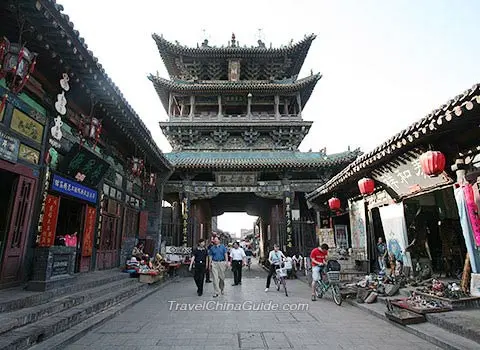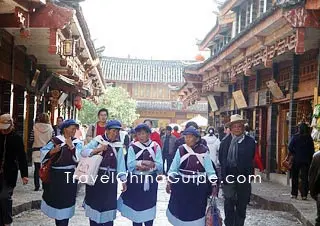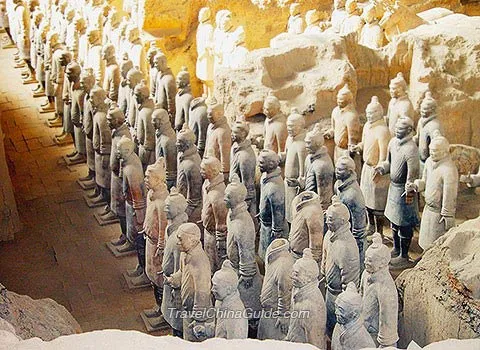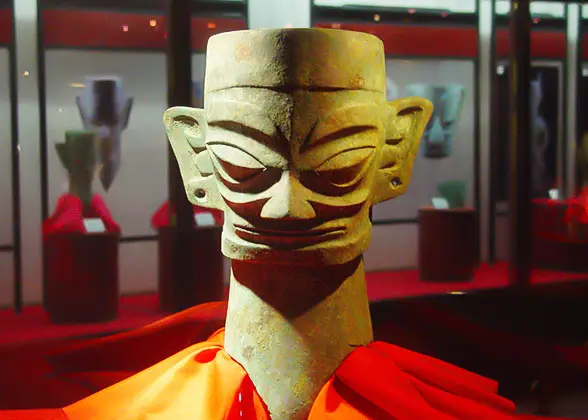Home /
10 Old Capitals of China
In the 5,000 years’ history of China, altogether 20 dynasties rose and fell. These dynasties established their capitals in different parts of the country. Some of them even had more than one capital, while some moved their capital from one city to another. For these reasons, China has many old capitals. These old capitals of China acted as political, economic and cultural center of the country at that time. Previously, historians only recognized four ancient capitals of China, Xi’an, Beijing, Luoyang and Nanjing. As relevant researches went further, more cities have been included. In this article, we will introduce the 10 most famous ones.
1
Xi'an
Xi’an was installed as the capital city by thirteen dynasties in ancient China, including Western Zhou (1046 BC - 771 BC), Qin (221 BC-207 BC), Western Han (202 BC – 9 AD), Xin (9-23), Eastern Han (25-220), Western Jin (265-316), Former Zhao (304-329), Former Qin (351-394), Later Qin (384-417), Western Wei (535-557), Northern Zhou (557-581), Sui (581-618) and Tang (618-907).
From the time it was made the capital of the Western Zhou, Xi'an exerted political, economic and cultural influence on other areas for the ensuing 1,200 years. After Emperor Qin Shi Huang ended the political chaos in 221 BC, Xi’an became the first capital of a unified China. After the Silk Road was established from here in the Western Han, Xi’an, called Chang’an at that time, quickly became the center of oriental civilization, enjoying equal reputation with ancient Rome. This capital’s prosperity reached its zenith during the Tang Dynasty. Great strides were made in developing industry, commerce, Buddhism, poet, architecture, etc. Overseas envoys and students visited it in an endless stream.
However, as the national economic center shifted southwards, the disadvantages of its inland location were exposed and Xi'an soon lost its political influence. Nevertheless, given its ancient glory, Xi’an definitively lives up to its status as one of the four great ancient capitals of China.
 Famous Historical Sites:
Famous Historical Sites:
 Terracotta Army – 2,200 years; groups of funerary statues for Emperor Qin Shi Huang (259 BC – 210 BC)
Terracotta Army – 2,200 years; groups of funerary statues for Emperor Qin Shi Huang (259 BC – 210 BC)
 Giant Wild Goose Pagoda (Dayan Pagoda) – 1,300 years; Buddhist shrine from the Tang Dynasty
Giant Wild Goose Pagoda (Dayan Pagoda) – 1,300 years; Buddhist shrine from the Tang Dynasty
 Xi’an City Wall – 650 years; fortifications of the Ming Dynasty’s northwestern stronghold
Xi’an City Wall – 650 years; fortifications of the Ming Dynasty’s northwestern stronghold
 Bell Tower & Drum Tower – 640 years; to tell time and emergency warning in the Ming Dynasty
Bell Tower & Drum Tower – 640 years; to tell time and emergency warning in the Ming Dynasty
 Recommended Tour:
Recommended Tour:  3 Days Xi'an Private Tour with Hotel from $339
3 Days Xi'an Private Tour with Hotel from $339
From the time it was made the capital of the Western Zhou, Xi'an exerted political, economic and cultural influence on other areas for the ensuing 1,200 years. After Emperor Qin Shi Huang ended the political chaos in 221 BC, Xi’an became the first capital of a unified China. After the Silk Road was established from here in the Western Han, Xi’an, called Chang’an at that time, quickly became the center of oriental civilization, enjoying equal reputation with ancient Rome. This capital’s prosperity reached its zenith during the Tang Dynasty. Great strides were made in developing industry, commerce, Buddhism, poet, architecture, etc. Overseas envoys and students visited it in an endless stream.
However, as the national economic center shifted southwards, the disadvantages of its inland location were exposed and Xi'an soon lost its political influence. Nevertheless, given its ancient glory, Xi’an definitively lives up to its status as one of the four great ancient capitals of China.
2
Beijing
Beijing is an old capital of China with more than 3,000 years’ history. Back in the Eastern Zhou Dynasty (770BC – 256 BC), it was the territory of two vassal states, Ji and Yan. Later, it became the auxiliary capital of the Liao Dynasty (907-1125) and the capital of the Jin Dynasty (1115-1234). In 1267, Mongolian Kublai Khan established the Yuan Dynasty (1271-1368) here. From that time on, Beijing totally replaced Xi’an and Luoyang, and was associated with increasing political importance. Emperors of the two following dynasties, the last two ancient dynasties of China, Ming (1368-1644) and Qing (1644-1911), also chose here as their capital.
During the dynasties above, political supremacy and hierarchy were directly represented through the architecture layout, which featured a squarish and symmetrical shape. Since emperors promoted cultural education of the people, this ancient capital of China also witnessed the prosperity of Yuan Drama and Ming-Qing Fiction.
 Famous Historical Sites:
Famous Historical Sites:
 Forbidden City – over 600 years; royal palace of the Ming and Qing Dynasties
Forbidden City – over 600 years; royal palace of the Ming and Qing Dynasties
 Temple of Heaven – 600 years; where emperors of the Ming and Qing Dynasties worshiped god and prayed for rain and a good harvest
Temple of Heaven – 600 years; where emperors of the Ming and Qing Dynasties worshiped god and prayed for rain and a good harvest
 Badaling Great Wall – 500 years; an important military fortification to protect the capital in Ming Dynasty
Badaling Great Wall – 500 years; an important military fortification to protect the capital in Ming Dynasty
 Summer Palace – 270 years; imperial garden of the Qing Dynasty
Summer Palace – 270 years; imperial garden of the Qing Dynasty
 Recommended Tour:
Recommended Tour:  5 Days Private Beijing Tour with Hotel from $129
5 Days Private Beijing Tour with Hotel from $129
During the dynasties above, political supremacy and hierarchy were directly represented through the architecture layout, which featured a squarish and symmetrical shape. Since emperors promoted cultural education of the people, this ancient capital of China also witnessed the prosperity of Yuan Drama and Ming-Qing Fiction.
3
Luoyang
Historically known as Luoyi or Luojing, Luoyang has long been a rival to Xi’an as another ancient capital of China. In history, there were also thirteen dynasties setting their capitals here, including the Xia (21st – 17th century BC), Shang (17th century BC – 1046 BC), Eastern Zhou, Eastern Han, Kingdom of Wei (220-265), Western Jin, Northern Wei (386-534), Sui, Tang, Wuzhou (690-705), Later Liang (907-923), Later Tang (923-936) and Later Jin (936-946) Dynasties.
Actually, it is no need for Luoyang to contend for a title because its uniqueness is absolutely irreplaceable. Heluo Culture, which originated from here, is considered the source of Chinese civilization. Also, Luoyang was where Confucianism, Buddhism and Taoism gained popularity in the earliest times. In addition, being located at the junction of the Silk Road and the Sui-Tang Grand Canal, Luoyang was an economic and cultural center in ancient China, and Luoyang Peony has been extolled up to this day.
 Famous Historical Sites:
Famous Historical Sites:
 Longmen Grottoes – over1,500 years; Buddhist architecture with engravings from the Northern Wei to the Qing Dynasty
Longmen Grottoes – over1,500 years; Buddhist architecture with engravings from the Northern Wei to the Qing Dynasty
 White Horse Temple – nearly 2,000 years; the first official Buddhist temple in China
White Horse Temple – nearly 2,000 years; the first official Buddhist temple in China
 Shaolin Temple – over 1,500 years; the birthplace of Chinese Kung Fu and Zen Buddhism
Shaolin Temple – over 1,500 years; the birthplace of Chinese Kung Fu and Zen Buddhism
 Museum of Luoyang Eastern Zhou Royal Horse and Chariot Pits - over 2,200 years, a large-scale burial pit of royal horses and chariots of the Eastern Zhou Dynasty
Museum of Luoyang Eastern Zhou Royal Horse and Chariot Pits - over 2,200 years, a large-scale burial pit of royal horses and chariots of the Eastern Zhou Dynasty
 Recommended Tour:
Recommended Tour:  Luoyang Essence Day Tour from $129
Luoyang Essence Day Tour from $129
Actually, it is no need for Luoyang to contend for a title because its uniqueness is absolutely irreplaceable. Heluo Culture, which originated from here, is considered the source of Chinese civilization. Also, Luoyang was where Confucianism, Buddhism and Taoism gained popularity in the earliest times. In addition, being located at the junction of the Silk Road and the Sui-Tang Grand Canal, Luoyang was an economic and cultural center in ancient China, and Luoyang Peony has been extolled up to this day.
4
Nanjing
The earliest written record of Nanjing area dated back to 571 BC. In 229 AD, Sun Quan established the Kingdom of Wu (222-280) here, which ushered in Nanjing's heyday, being the continuous capital for six important dynasties. The other five are the Eastern Jin (317-420), Song (420-479), Qi (479-502), Liang (502-557) and Chen (557-589) of Southern Dynasties. During this period, Nanjing was one of the largest cities in the world with over one million population. Also, affluent life inclined people to pursue spiritual satisfaction, and the system of ancient poetry, music, calligraphy and painting was preliminarily formed meanwhile. Later, when Nanjing was the capital of the Southern Tang (937-975), Southern Song (1127-1279) and Ming Dynasties, handicraft industry and commodity economy developed a lot in the Qinhuai River Valley.
Also, as the capital of the Taiping Heavenly Kingdom (1851-1864), and then the Republic of China (1912-1949), Nanjing witnessed China’s historic change from feudal monarchy to republican regime. Unfortunately, an appalling massacre hit this old capital of China in 1937, a fatal blow to the economy and infrastructure of this China capital, prior to Beijing.
 Famous Historical Sites:
Famous Historical Sites:
 Confucius Temple – 1,700 years; place of worship for Confucius, also China’s first highest imperial academy
Confucius Temple – 1,700 years; place of worship for Confucius, also China’s first highest imperial academy
 Xiaoling Mausoleum of Ming Dynasty – 630 years; burial place for Emperor Zhu Yuanzhang (1328-1398), the founder of Ming Dynasty and his empress
Xiaoling Mausoleum of Ming Dynasty – 630 years; burial place for Emperor Zhu Yuanzhang (1328-1398), the founder of Ming Dynasty and his empress
 Presidential Palace – 160 years; worksite of the government officials from Ming to Republic of China
Presidential Palace – 160 years; worksite of the government officials from Ming to Republic of China
 Dr. Sun Yat-sen’s Mausoleum – 90 years; burial place for Sun Yat-sen (1866-1925), pioneer of China’s democratic revolution
Dr. Sun Yat-sen’s Mausoleum – 90 years; burial place for Sun Yat-sen (1866-1925), pioneer of China’s democratic revolution
 Recommended Tour:
Recommended Tour:  Picturesque South China Towns
Picturesque South China Towns
Also, as the capital of the Taiping Heavenly Kingdom (1851-1864), and then the Republic of China (1912-1949), Nanjing witnessed China’s historic change from feudal monarchy to republican regime. Unfortunately, an appalling massacre hit this old capital of China in 1937, a fatal blow to the economy and infrastructure of this China capital, prior to Beijing.
5
Kaifeng
Situated in the eastern Henan Province of central China, Kaifeng boasts a history of over 4,100 years. At the very beginning, it was the capital of the Xia Dynasty and the State of Wei (403 BC – 225 BC). However, it was not until the Five Dynasties (907-960) that Kaifeng consolidated its position as a historical capital of China. During the Later Liang (907-923), Later Jin (936-946), Later Han (947-950) and Later Zhou (951-960), the people in Kaifeng were no longer saddled with heavy taxation and could fully focus on developing the economy, which directly led to the shift of the political center from Luoyang to Kaifeng.
The zenith of this old capital of China came during the Northern Song Dynasty (960-1127). At that time, more than 1.5 million people in their capital enjoyed abundant food, an advanced commodity-based economy and a diversified culture. Such prosperity was captured by Zhang Zeduan in his painting the “Riverside Scene at the Qingming Festival”. After that, Kaifeng also served as the capital of the Jin Dynasty and the auxiliary capital of the Ming Dynasty.
 Famous Historical Sites:
Famous Historical Sites:
 Xiangguo Temple – 1,500 years; the biggest Buddhist temple in the Northern Song Dynasty
Xiangguo Temple – 1,500 years; the biggest Buddhist temple in the Northern Song Dynasty
 Memorial Temple of Lord Bao – about 1,100 years; administrative and judicial office in the Northern Song Dynasty
Memorial Temple of Lord Bao – about 1,100 years; administrative and judicial office in the Northern Song Dynasty
 Iron Pagoda – Nearly 1,000 years; acclaimed as the No. 1 Pagoda in ancient China
Iron Pagoda – Nearly 1,000 years; acclaimed as the No. 1 Pagoda in ancient China
The zenith of this old capital of China came during the Northern Song Dynasty (960-1127). At that time, more than 1.5 million people in their capital enjoyed abundant food, an advanced commodity-based economy and a diversified culture. Such prosperity was captured by Zhang Zeduan in his painting the “Riverside Scene at the Qingming Festival”. After that, Kaifeng also served as the capital of the Jin Dynasty and the auxiliary capital of the Ming Dynasty.
6
Hangzhou
The earliest civilization found in Hangzhou area is the Liangzhu Culture of more than 5,000 years. It was not until the Sui Dynasty (581-618) that Hangzhou was elevated from a prefecture to a city. In the Five Dynasties and Ten States (907-960), Hangzhou was chosen as the capital, for the first time, of the State of Wuyue (907-987).
The second time it had been made capital was in the Southern Song Dynasty, when Hangzhou also reached its peak in all aspects. Since a large amount of population moved to this ancient capital of China, Hangzhou luckily experienced favorable conditions to improve productivity and develop commerce. Manual workshops, taverns, tea houses, theaters and academies were all over the area. Meanwhile, Hangzhou maintained positive diplomatic and business relationships with over 50 countries, such as Japan, Korea, Persia and Arab.
Despite its declining political function after the Southern Song, Hangzhou kept bringing its economic strength into full play. Thanks to the Grand Canal, it had long been a distributing center, especially for silk and grain, in ancient China.
 Famous Historical Sites:
Famous Historical Sites:
 West Lake – 2,000 years; with bridges, pavilions, pagodas and temples over and around it
West Lake – 2,000 years; with bridges, pavilions, pagodas and temples over and around it
 Lingyin Temple – 1,700 years; one of the most famous Buddhist temples in ancient times
Lingyin Temple – 1,700 years; one of the most famous Buddhist temples in ancient times
 Grand Canal – over 1,500 years; the longest canal in the world
Grand Canal – over 1,500 years; the longest canal in the world
 Wuzhen Water Town – 1,300 years; typical ancient town in southern China
Wuzhen Water Town – 1,300 years; typical ancient town in southern China
 Recommended Tour:
Recommended Tour:  4 Days Private Hangzhou Tour
4 Days Private Hangzhou Tour
The second time it had been made capital was in the Southern Song Dynasty, when Hangzhou also reached its peak in all aspects. Since a large amount of population moved to this ancient capital of China, Hangzhou luckily experienced favorable conditions to improve productivity and develop commerce. Manual workshops, taverns, tea houses, theaters and academies were all over the area. Meanwhile, Hangzhou maintained positive diplomatic and business relationships with over 50 countries, such as Japan, Korea, Persia and Arab.
Despite its declining political function after the Southern Song, Hangzhou kept bringing its economic strength into full play. Thanks to the Grand Canal, it had long been a distributing center, especially for silk and grain, in ancient China.
It is hold by many people that the Yellow Emperor, the ancestor of the Chinese, was born in Zhengzhou area more than 5,000 years ago. Later, Zhengzhou witnessed the establishment of the Xia Dynasty and many believe became the first capital of China, though controversial. However, it has been confirmed that the second dynasty in China’s history, Shang, once made here its capital city, because the relics of Shang’s City Wall are well preserved to this day in the Guancheng District in downtown Zhengzhou.
Since Zhengzhou is located at the center of the hinterland, ancient politicians considered it the best place from which to administer the whole country. According to written records, since the Xia Dynasty, there were more than 200 emperors of 20 dynasties fulfilling their political ambitions right here. However, owing to the frequent alternation of regimes, Zhengzhou was never a capital for long.
 Famous Historical Sites:
Famous Historical Sites:
 Songyang Academy – about 1,500 years; one of the four most famous academies in ancient China, mainly imparting Confucianism
Songyang Academy – about 1,500 years; one of the four most famous academies in ancient China, mainly imparting Confucianism
 Zhongyue Temple – 2,000 years; a well-reserved Taoist temple
Zhongyue Temple – 2,000 years; a well-reserved Taoist temple
Since Zhengzhou is located at the center of the hinterland, ancient politicians considered it the best place from which to administer the whole country. According to written records, since the Xia Dynasty, there were more than 200 emperors of 20 dynasties fulfilling their political ambitions right here. However, owing to the frequent alternation of regimes, Zhengzhou was never a capital for long.
8
Anyang
Anyang is best known as the capital of the Shang Dynasty, because two representative relics, oracle and bronzeware, were unearthed here. Oracle is the inscription on bones or tortoise shells, and is regarded as the prototype of Chinese characters. Anyang was once again put under spotlight when the Simuwu Quadripod, the largest bronzeware in the world, was excavated. More oracles and bronzeware are displayed at the Yin Xu Scenic Area.
Compared with other ancient capitals of China, Anyang was politically influential for a shorter period of time, mainly during the Three Kingdoms (220-280) and the Northern and Southern Dynasties (420-589). Specific regimes include the Kingdom of Wei (220-265), Later Zhao (319-351), Ranwei (350-352), Former Yan (352-370), Eastern Wei (534-550) and Northern Qi (550-577).
 Famous Historical Sites:
Famous Historical Sites:
 Yin Xu (Yin Ruins) – 3,200 years; architecture remains of the late Shang Dynasty, also including bronzeware and inscriptions on shells and bones
Yin Xu (Yin Ruins) – 3,200 years; architecture remains of the late Shang Dynasty, also including bronzeware and inscriptions on shells and bones
 Wenfeng Pagoda – about 1,100 years; umbrella-shaped Buddhist pagoda
Wenfeng Pagoda – about 1,100 years; umbrella-shaped Buddhist pagoda
 Youlicheng Scenic Area – 3,000 years; the first prison in ancient China, also the cradle of Zhouyi Culture
Youlicheng Scenic Area – 3,000 years; the first prison in ancient China, also the cradle of Zhouyi Culture
 Yuan Lin – 100 years; tomb for Yuan Shikai (1859-1916), the first president of the Republic of China, and his wife
Yuan Lin – 100 years; tomb for Yuan Shikai (1859-1916), the first president of the Republic of China, and his wife
Compared with other ancient capitals of China, Anyang was politically influential for a shorter period of time, mainly during the Three Kingdoms (220-280) and the Northern and Southern Dynasties (420-589). Specific regimes include the Kingdom of Wei (220-265), Later Zhao (319-351), Ranwei (350-352), Former Yan (352-370), Eastern Wei (534-550) and Northern Qi (550-577).
9
Shangqiu
Shangqiu was the fifth capital of the Xia Dynasty and the first capital of the Shang and Southern Song Dynasties. Also, it was the auxiliary capital of the Northern Song Dynasty and other vassal states in ancient China.
During the Shang Dynasty, people in this area often drove an ox cart loaded with goods to barter with other tribes. Over time, more and more businessmen and commodities sprung up, thus scholars consider Shangqiu the origin of China’s trading business.
During the Song Dynasty, Shangqiu made the most noticeable progress in culture. Considering that this area had a sound base of Confucianism, Buddhism and Taoism, many students came here to study for the imperial examination. Against this backdrop, the Academy of Yingtian Prefecture in Shangqiu gathered an increasing number of talented people, and represented the highest education level available at that time.
 Famous Historical Sites:
Famous Historical Sites:
 Shangqiu Ancient City – 4,000 years; including six ancient cities of the Zhou, Qin, Han, Sui, Tang, Northern Song and Yuan Dynasties.
Shangqiu Ancient City – 4,000 years; including six ancient cities of the Zhou, Qin, Han, Sui, Tang, Northern Song and Yuan Dynasties.
 Academy of Yingtian Prefecture – nearly 1,100 years; one of the four most famous academies in ancient China, reached its zenith in the Northern Song Dynasty
Academy of Yingtian Prefecture – nearly 1,100 years; one of the four most famous academies in ancient China, reached its zenith in the Northern Song Dynasty
During the Shang Dynasty, people in this area often drove an ox cart loaded with goods to barter with other tribes. Over time, more and more businessmen and commodities sprung up, thus scholars consider Shangqiu the origin of China’s trading business.
During the Song Dynasty, Shangqiu made the most noticeable progress in culture. Considering that this area had a sound base of Confucianism, Buddhism and Taoism, many students came here to study for the imperial examination. Against this backdrop, the Academy of Yingtian Prefecture in Shangqiu gathered an increasing number of talented people, and represented the highest education level available at that time.
10
Chengdu
With more than 3,100 years’ history, this old capital of China is the birthplace of Ancient Shu Culture. In 256 BC during the Qin Dynasty, an official, Li Bing, supervised the construction of the Dujiangyan Irrigation System, which significantly promoted Chengdu’s agriculture and turned this place into the Land of Abundance. Later, Chengdu became one of the five largest cities of the Han Dynasty, particularly famous for producing superior silk and fabric.
Subsequently, four regimes established their capital here, including the Kingdom of Shu (221-263), Cheng Han (304-349), Former Shu (907-925) and Later Shu (934-966). During the Northern Song Dynasty, Chengdu was the second largest city. The appearance of Jiaozi, which is the earliest paper money in the world, and the thriving printing industry all reflected its economic prosperity at that time.
 Famous Historical Sites:
Famous Historical Sites:
 Dujiangyan Irrigation System – 2,300 years; water conservancy constructed in the Warring States Period to prevent flood and improve irrigation
Dujiangyan Irrigation System – 2,300 years; water conservancy constructed in the Warring States Period to prevent flood and improve irrigation
 Wuhou Temple – 1,800 years; memorial temple for Zhuge Liang (181-234), the prime minister, strategist and writer of the Kingdom of Shu in the Three Kingdoms period
Wuhou Temple – 1,800 years; memorial temple for Zhuge Liang (181-234), the prime minister, strategist and writer of the Kingdom of Shu in the Three Kingdoms period
 Wenshu Monastery – 1,400 years; the most important Buddhist temple in the Yangtze River Valley
Wenshu Monastery – 1,400 years; the most important Buddhist temple in the Yangtze River Valley
 Thatched Cottage of Du Fu – 1,250 years; where Du Fu, one of the most famous poets of the Tang Dynasty, lived for four years and composed more than 240 poems
Thatched Cottage of Du Fu – 1,250 years; where Du Fu, one of the most famous poets of the Tang Dynasty, lived for four years and composed more than 240 poems
 Recommended Tour:
Recommended Tour:  3 Days Chengdu Private Tour from $299
3 Days Chengdu Private Tour from $299
Subsequently, four regimes established their capital here, including the Kingdom of Shu (221-263), Cheng Han (304-349), Former Shu (907-925) and Later Shu (934-966). During the Northern Song Dynasty, Chengdu was the second largest city. The appearance of Jiaozi, which is the earliest paper money in the world, and the thriving printing industry all reflected its economic prosperity at that time.
You May Like
- Last updated on Aug. 06, 2025 by Gabby Li -



